I will detail this issue because I think it makes it easier for you to help me identify the problem that is occurring.
You will see two codes. The first one is just a function to generate graphs according to a certain date and category. According to the date (30/06 and 01/07) and category (FDE and ABC) options I can generate four different graphics (I inserted the images for you to see). If I just use this function, it works normally.
However, I have the second code I made to use this same function of code 1, but in Shiny. I built the code in Shiny, but it doesn't work very well. The code only worked for the first graph, because I defined my dmda and CategoryChosse. However, I want the code to be able to generate for both dates/categories. If by chance I build it wrong on shiny, feel free to tweak it as best you like. I am open to suggestions.
First code
library(dplyr)
library(tidyverse)
library(lubridate)
df1 <- structure(
list(date1= c("2021-06-28","2021-06-28","2021-06-28","2021-06-28"),
date2 = c("2021-06-30","2021-06-30","2021-07-01","2021-07-01"),
Category = c("FDE","ABC","FDE","ABC"),
Week= c("Wednesday","Wednesday","Friday","Friday"),
DR1 = c(4,1,6,3),
DR01 = c(4,1,4,3), DR02= c(4,2,6,2),DR03= c(9,5,4,7),
DR04 = c(5,4,3,2),DR05 = c(5,4,5,4),
DR06 = c(2,4,3,2),DR07 = c(2,5,4,4),
DR08 = c(3,4,5,4),DR09 = c(2,3,4,4)),
class = "data.frame", row.names = c(NA, -4L))
f1 <- function(dmda, CategoryChosse) {
x<-df1 %>% select(starts_with("DR0"))
x<-cbind(df1, setNames(df1$DR1 - x, paste0(names(x), "_PV")))
PV<-select(x, date2,Week, Category, DR1, ends_with("PV"))
med<-PV %>%
group_by(Category,Week) %>%
summarize(across(ends_with("PV"), median))
SPV<-df1%>%
inner_join(med, by = c('Category', 'Week')) %>%
mutate(across(matches("^DR0\\d+$"), ~.x +
get(paste0(cur_column(), '_PV')),
.names = '{col}_{col}_PV')) %>%
select(date1:Category, DR01_DR01_PV:last_col())
SPV<-data.frame(SPV)
mat1 <- df1 %>%
filter(date2 == dmda, Category == CategoryChosse) %>%
select(starts_with("DR0")) %>%
pivot_longer(cols = everything()) %>%
arrange(desc(row_number())) %>%
mutate(cs = cumsum(value)) %>%
filter(cs == 0) %>%
pull(name)
(dropnames <- paste0(mat1,"_",mat1, "_PV"))
SPV <- SPV %>%
filter(date2 == dmda, Category == CategoryChosse) %>%
select(-any_of(dropnames))
datas<-SPV %>%
filter(date2 == ymd(dmda)) %>%
group_by(Category) %>%
summarize(across(starts_with("DR0"), sum)) %>%
pivot_longer(cols= -Category, names_pattern = "DR0(.+)", values_to = "val") %>%
mutate(name = readr::parse_number(name))
colnames(datas)[-1]<-c("Days","Numbers")
datas <- datas %>%
group_by(Category) %>%
slice((as.Date(dmda) - min(as.Date(df1$date1) [
df1$Category == first(Category)])):max(Days)+1) %>%
ungroup
plot(Numbers ~ Days, xlim= c(0,45), ylim= c(0,30),
xaxs='i',data = datas,main = paste0(dmda, "-", CategoryChosse))
model <- nls(Numbers ~ b1*Days^2+b2,start = list(b1 = 0,b2 = 0),data = datas, algorithm = "port")
new.data <- data.frame(Days = with(datas, seq(min(Days),max(Days),len = 45)))
new.data <- rbind(0, new.data)
lines(new.data$Days,predict(model,newdata = new.data),lwd=2)
coef<-coef(model)[2]
points(0, coef, col="red",pch=19,cex = 2,xpd=TRUE)
text(.99,coef + 1,max(0, round(coef,1)), cex=1.1,pos=4,offset =1,col="black")
}
f1("2021-06-30", "FDE")
f1("2021-06-30", "ABC")
f1("2021-07-01", "FDE")
f1("2021-07-01", "ABC")
Second code
library(shiny)
library(shinythemes)
library(dplyr)
library(tidyverse)
library(lubridate)
library(stringr)
function.test<-function(dmda,CategoryChosse){
df1 <- structure(
list(date1= c("2021-06-28","2021-06-28","2021-06-28","2021-06-28"),
date2 = c("2021-06-30","2021-06-30","2021-07-01","2021-07-01"),
Category = c("FDE","ABC","FDE","ABC"),
Week= c("Wednesday","Wednesday","Friday","Friday"),
DR1 = c(4,1,6,3),
DR01 = c(4,1,4,3), DR02= c(4,2,6,2),DR03= c(9,5,4,7),
DR04 = c(5,4,3,2),DR05 = c(5,4,5,4),
DR06 = c(2,4,3,2),DR07 = c(2,5,4,4),
DR08 = c(3,4,5,4),DR09 = c(2,3,4,4)),
class = "data.frame", row.names = c(NA, -4L))
dmda<-"2021-06-30"
CategoryChosse<-"FDE"
f1 <- function(dmda, CategoryChosse) {
x<-df1 %>% select(starts_with("DR0"))
x<-cbind(df1, setNames(df1$DR1 - x, paste0(names(x), "_PV")))
PV<-select(x, date2,Week, Category, DR1, ends_with("PV"))
med<-PV %>%
group_by(Category,Week) %>%
summarize(across(ends_with("PV"), median))
SPV<-df1%>%
inner_join(med, by = c('Category', 'Week')) %>%
mutate(across(matches("^DR0\\d+$"), ~.x +
get(paste0(cur_column(), '_PV')),
.names = '{col}_{col}_PV')) %>%
select(date1:Category, DR01_DR01_PV:last_col())
SPV<-data.frame(SPV)
mat1 <- df1 %>%
filter(date2 == dmda, Category == CategoryChosse) %>%
select(starts_with("DR0")) %>%
pivot_longer(cols = everything()) %>%
arrange(desc(row_number())) %>%
mutate(cs = cumsum(value)) %>%
filter(cs == 0) %>%
pull(name)
(dropnames <- paste0(mat1,"_",mat1, "_PV"))
SPV <- SPV %>%
filter(date2 == dmda, Category == CategoryChosse) %>%
select(-any_of(dropnames))
datas<-SPV %>%
filter(date2 == ymd(dmda)) %>%
group_by(Category) %>%
summarize(across(starts_with("DR0"), sum)) %>%
pivot_longer(cols= -Category, names_pattern = "DR0(.+)", values_to = "val") %>%
mutate(name = readr::parse_number(name))
colnames(datas)[-1]<-c("Days","Numbers")
datas <- datas %>%
group_by(Category) %>%
slice((as.Date(dmda) - min(as.Date(df1$date1) [
df1$Category == first(Category)])):max(Days)+1) %>%
ungroup
plot(Numbers ~ Days, xlim= c(0,45), ylim= c(0,30),
xaxs='i',data = datas,main = paste0(dmda, "-", CategoryChosse))
model <- nls(Numbers ~ b1*Days^2+b2,start = list(b1 = 0,b2 = 0),data = datas, algorithm = "port")
new.data <- data.frame(Days = with(datas, seq(min(Days),max(Days),len = 45)))
new.data <- rbind(0, new.data)
lines(new.data$Days,predict(model,newdata = new.data),lwd=2)
coef<-coef(model)[2]
points(0, coef, col="red",pch=19,cex = 2,xpd=TRUE)
text(.99,coef + 1,max(0, round(coef,1)), cex=1.1,pos=4,offset =1,col="black")
}
Plot1<- f1(dmda, CategoryChosse)
return(list(
"Plot1" = Plot1,
date2 = df1$date2,
data = df1
))
}
ui <- fluidPage(
ui <- shiny::navbarPage(theme = shinytheme("flatly"), collapsible = TRUE,
br(),
tabPanel("",
sidebarLayout(
sidebarPanel(
uiOutput("date"),
uiOutput("mycode"),
br(),
),
mainPanel(
tabsetPanel(
tabPanel("", plotOutput("graph",width = "100%", height = "600")
)
),
))
)))
server <- function(input, output,session) {
data <- reactive(function.test(df1))
output$date <- renderUI({
all_dates <- seq(as.Date('2021-01-01'), as.Date('2021-01-15'), by = "day")
disabled <- as.Date(setdiff(all_dates, as.Date(data()$date2)), origin = "1970-01-01")
dateInput(input = "date2",
label = h4("Data"),
min = min(data()$date2),
max = max(data()$date2),
value = min(data()$date2),
format = "dd-mm-yyyy",
datesdisabled = disabled)
})
output$mycode <- renderUI({
req(input$date2)
df1 <- data()$data
df2 <- df1[as.Date(df1$date2) %in% input$date2,]
selectInput("code", label = h4("Code"),choices=unique(df2$Category))
})
output$graph <- renderPlot({
req(input$date2,input$code)
function.test(as.character(input$date2),as.character(input$code))[["Plot1"]]
})
}
shinyApp(ui = ui, server = server)
And if I have this database
df1 <- structure(
list(date1= c("2021-06-28","2021-06-28","2021-06-28","2021-06-28","2021-06-28"),
date2 = c("2021-06-25","2021-06-30","2021-06-30","2021-07-01","2021-07-01"),
Category = c("FDE", "FDE","ABC","FDE","ABC"),
Week= c("Tuesday", "Wednesday","Wednesday","Friday","Friday"),
DR1 = c(2,4,1,6,3),
DR01 = c(2,4,1,4,3), DR02= c(2,4,2,6,2),DR03= c(2,9,5,4,7),
DR04 = c(2,5,4,3,2),DR05 = c(2,5,4,5,4),
DR06 = c(2,2,4,3,2),DR07 = c(2,2,5,4,4),
DR08 = c(2,3,4,5,4),DR09 = c(2,2,3,4,4)),
class = "data.frame", row.names = c(NA, -5L))




](../../images/3824290954.webp)